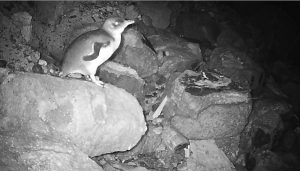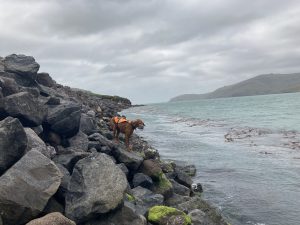
The White-flippered Penguin/Korora is only found in Canterbury and breeds around Te Whakaraupō/Lyttelton Harbour area – with many of our flippered friends calling the Port home during their nesting season.
It’s one of the world’s smallest penguins, growing up to 30cm tall and weighing only 1.5kg. Nesting season is a particularly vulnerable time for these special animals and LPC’s Environment team works hard to protect them against predators and keep Port activities away from their nesting sites.
“White-flippered penguins will come ashore to nest during the night and leave to hunt during the day,” says LPC’s Environment and Sustainability Advisor, Charlotte Jones.
“It’s crucial that we protect them during this important time, particularly given that these penguins are an ‘At Risk’ species with declining numbers.”
From August to February, the penguins settle in nesting spots at the seawalls around the Port, often finding hollows in the rocks for shelter from the elements and to hide from predators.
This year, in collaboration with Boffa Miskell, Kaikōura Ocean Research Institute, Fulton Hogan and Higgins, LPC facilitated the creation of 27 new nesting boxes – seven on the east side of the Port and a further 20 at Naval Point. Built from redirected waste materials, the new nesting boxes create a safe space for penguins to nest away from people, dogs and pests.
“It might take a few years for the penguins to discover and use the boxes, but we’re planning for the future to enhance Te Whakaraupō/Lyttelton Harbour’s habitat and make sure these special penguins are here for many years to come,” says Charlotte.
LPC also partners with Kaikōura Ocean Research Institute to complete a yearly penguin survey, where Mena, a specially trained conservation dog, and her handler search all of the Port’s seawalls to identify existing and new penguin nesting sites. This year’s survey found nine nesting sites, but some years they’ve found up to 20.

“We’ve also started some predator control work around the Port in the last few months,” says Charlotte.
“We’re focusing our pest trapping around the Battery Point area initially to catch pests at the source. Ecologists identified it as a risky area where predators are sort of funnelled down onto the seawall, making our penguins really vulnerable.”
The Environment team installed trail cameras around the area over winter to investigate the best spots to place the traps. Around 20 traps are now currently operating, with plans to expand predator control to other areas of the Port in the coming years.
“So far we’ve been catching mainly rats and a few hedgehogs, but there’s definitely some possums and feral cats that have been lurking around,” says Charlotte.
“We’re also about to install some traps at the Port Saddle in the next few months. It’s a really important place for LPC and we’re committed to restoring this land, in partnership with the Banks Peninsula Conservation Trust, with indigenous flora and fauna and protecting the area so it can be enjoyed by future generations.”